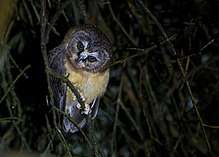Unspotted saw-whet owl
The unspotted saw-whet owl (Aegolius ridgwayi) is a small owl. It is a resident breeder in the highlands of Central America from southern Mexico south to western Panama, mainly at altitudes above 2500 m. It has occasionally been considered conspecific with the northern saw-whet owl. There are currently no recognized subspecies.[2]
| Unspotted saw-whet owl | |
|---|---|
 | |
| Scientific classification | |
| Kingdom: | Animalia |
| Phylum: | Chordata |
| Class: | Aves |
| Order: | Strigiformes |
| Family: | Strigidae |
| Genus: | Aegolius |
| Species: | A. ridgwayi |
| Binomial name | |
| Aegolius ridgwayi (Alfaro, 1905) | |
This nocturnal bird breeds in open mountain forests, in both the cloud forest and the higher oak woodland, laying its eggs in a tree hole. It hunts rodents, shrews and other small mammals as its main prey, but will also feed on birds, bats and insects.
The unspotted saw-whet owl is a small, dumpy, short-tailed and broad-winged owl, approximately 18 cm long and weighing approximately 80 g. It is dark brown above with white markings on the wings. The underparts are unstreaked buff, becoming darker on the upper chest and facial disc. The head is large, with yellow eyes and a white-edged facial disc. The flight is fluttery and agile.
The voice of the unspotted saw-whet owl is a series of rhythmic toots. Reports of this owl at lower altitudes are invariably due to the extremely similar call of an Anotheca tree frog.
The scientific species name is for the American ornithologist Robert Ridgway.
References
| Wikispecies has information related to Aegolius ridgwayi |
| Wikimedia Commons has media related to Aegolius ridgwayi. |
- BirdLife International (2012). "Aegolius ridgwayi". IUCN Red List of Threatened Species. 2012. Retrieved 26 November 2013.CS1 maint: ref=harv (link)
- "Aegolius ridgwayi". Integrated Taxonomic Information System. Retrieved 5 April 2011.
- Stiles and Skutch A guide to the birds of Costa Rica ISBN 0-8014-9600-4
